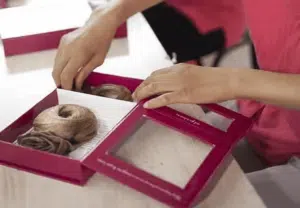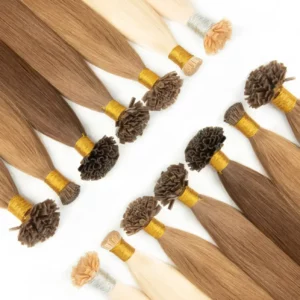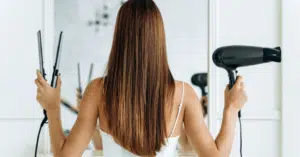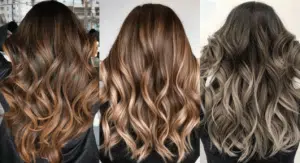Extensions stay beautiful when care is consistent, precise, and based on how hair fibers behave. Use this expert guide to learn how to take care of hair extensions, why each step matters, and exactly how to apply it at home.
For anyone asking how to care for hair extensions or how to maintain hair extensions: brush gently, wash 1–2 times per week with sulfate-free shampoo, condition mid-lengths to ends, always dry the base, use heat protectant at moderate temperatures, sleep with low friction, protect in pools and sun, book regular maintenance if the extensions are semi-permanent, and store temporary pieces correctly.
1

Brushing: Technique, Tools, and Timing
Brushing protects the cuticle, prevents base tangles, and reduces stress at anchors. Poor technique creates traction, micro-breaks, and frizz.
Why it matters
- Hair fibers (especially processed blondes) have thinner cuticle plates. Excess pull roughens the cuticle and causes split ends.
- Anchors (beads, tapes, keratin tips) concentrate force. Unsupported brushing multiplies tension at a small point.
- Tangles accumulate at the nape from clothing friction; daily reset stops matting.
What to use
- Loop or soft-bristle brush for dry detangling (glides over wefts and bonds).
- Wide-tooth comb or fingers for wet detangling (reduces stretch on saturated fibers).
- Avoid hard plastic ball tips that snag stitches.
How to do it
- Hold the row/base with one hand; brush with the other.
- Start at the last 2–3 inches; clear small knots first; step upward in short strokes.
- Finish with full-length passes once the path is clear.
- Brush morning, before washing, and before bed.

Pro tips
- For static, place a pea-size drop of lightweight serum on ends only.
- For wind/gym days, keep a compact loop brush.
- Never rip through; pause and open knots with fingers first.
| Situation | Tool | Small rule | Risk if ignored |
|---|---|---|---|
| Daily dry detangle | Loop/soft-bristle | Support base, ends→roots | Traction, broken anchors |
| Post-wash | Wide-tooth/fingers | Add slip mid-lengths | Fiber stretch, snaps |
| Static season | Tiny serum on ends | Never at anchors | Slippage at base |
Washing: Clean Base, Hydrated Lengths
Over-washing dries fiber; under-washing irritates the scalp and weakens hold. Balance is the goal.
Why it matters
- Sebum and sweat can migrate along the base and loosen anchors if not removed.
- Surfactants that are too strong strip moisture; fibers without scalp oils need gentler cleansing.
- Thorough rinsing prevents residue that attracts dust and dulls shine.
Frequency
- Most people: 1–2 washes per week.
- Heavy workouts: quick rinse or scalp refresh between full washes.
Step-by-step
- Brush while supporting the base.
- Keep hair in natural fall; do not pile on the crown.
- Shampoo (sulfate-free) on scalp and along the row base; use straight, downward motions.
- Rinse until water runs clear.
- Apply conditioner from mid-shaft to ends only; never on beads/tapes.
- Rinse well; press out water with towel (no rough rubbing).
- Always blow-dry the base 100% dry; air-dry lengths if preferred.
| Step | Product | Purpose | Don’t do |
|---|---|---|---|
| Cleanse | Sulfate-free shampoo | Hygiene without slip | Scrub in circles |
| Condition | Light conditioner | Hydrate lengths | Touch anchors |
| Rinse | Plenty of water | No residue | Quick/partial rinse |
| Dry base | Blow-dryer, medium heat | Odor/slip prevention | Sleep with damp base |
Products: Ingredients That Help (and Hurt)
Choose formulas that clean gently, add slip on lengths, and protect from heat—without destabilizing anchors.
Shampoos
- Use: sulfate-free (e.g., sodium cocoyl isethionate, cocamidopropyl betaine).
- Avoid frequent use of strong SLS/SLES systems.
Conditioners
- Use: lightweight, with fatty alcohols (cetyl, stearyl) and cationics (behentrimonium chloride) on lengths.
- Avoid: heavy butters/oils at the base; they migrate and cause slip.
Leave-ins and serums
- Use: heat protectant sprays with film-formers (e.g., PVP/DMAPA acrylates, silicones) on lengths.
- Use: a pea-size serum on the last inches only.
- Avoid: high-alcohol finishing sprays; repeated use dries fiber.
UV and sunscreen caution
- Some chemical sunscreens (notably avobenzone) can discolor extensions, especially light blondes, when residues touch hair.
- Keep skin sunscreen off hair; wash hands before touching hair; prefer mineral sunscreens (zinc oxide, titanium dioxide) for face/neck or use hair-specific UV mists compatible with extensions.
| Product | Safe zone | Avoid zone | Reason |
|---|---|---|---|
| Shampoo (sulfate-free) | Scalp/base | — | Gentle cleanse |
| Conditioner (light) | Mid-lengths→ends | Base | Prevent slip |
| Heat protectant | All lengths | — | Thermal shield |
| Serum (light) | Ends only | Base | Oil migration |

Heat Styling: Control Temperature and Contact
Heat shapes fiber fast but dehydrates cuticle if misused.
Principles
- Temperature: about 355–375°F (180–190°C) with protectant.
- Passes: one slow pass beats many fast passes.
- Placement: keep irons/curlers off the anchor line.
Routine
- Brush and section.
- Mist heat protectant evenly; comb through.
- Curl/straighten with moderate heat; let curls cool to set.
- Finish with a cool shot to align cuticle.
- Plan heat-free days (braids, foam rollers).
Signs of heat fatigue
- Rough ends, dull patches, decreased elasticity.
- Response: lower temp, increase hydration masks on lengths, trim if needed.

Sleeping: Reduce Friction, Remove Moisture
Night friction at the nape and damp bases cause most hidden damage.
Night checklist
- Brush and detangle; support the base.
- Secure a loose braid or low pony with a soft scrunchie.
- Use silk/satin pillowcase to cut friction.
- Ensure the base is 100% dry before sleep.
Why it works
- Lower friction prevents micro-tangles and cuticle scuffing.
- Dry bases maintain anchor grip and stop odor.
Swimming (Pool and Ocean): Minimize Contact or Suit Up
Chlorine, bromine, copper algaecides, and saltwater extract moisture, roughen cuticle, and can discolor light shades. The safest path is to avoid exposing extensions to pool and sea water. If swimming is unavoidable, wear a snug silicone swim cap and follow strict prep and aftercare.
Best practice hierarchy (from safest to riskiest)
- Do not immerse extensions; keep hair completely dry and up.
- If entering water, wear a silicone swim cap (snug fit over a protective braid/bun).
- If a cap is not possible (last resort), use full barrier routine and keep exposure very short.

Pre-swim barrier routine (mandatory if you must go in)
- Detangle and set a single braid or low bun.
- Saturate hair thoroughly with clean tap water (reduces uptake of pool/sea water).
- Apply a small amount of silicone-rich leave-in or a swim-specific protective cream on mid-lengths to ends (never at anchors).
- Put on a tight silicone cap. For long/thick hair, try a double-cap method: thin fabric cap to compress hair, silicone cap over it for a seal.
In-water conduct
- Keep head above water as much as possible.
- Avoid diving and repeated submersion.
- Minimize session length.
Post-swim dechlorination/chelating
- Rinse immediately with plenty of fresh water.
- Use a gentle chelating shampoo once after pool exposure (look for EDTA, citric/ascorbic acid) to remove chlorine/copper residues that cause dryness or greenish tint.
- Condition mid-lengths to ends.
- Blow-dry the base completely.
Sunscreen and UV
- Choose hair-safe UV sprays designed for extensions or keep mineral skin sunscreens off the hair.
- Tie hair up while applying sunscreen; wash hands before touching hair or cap.
| Risk | Source | Prevention | Aftercare |
|---|---|---|---|
| Dryness | Chlorine/salt | Cap + pre-wet + barrier cream | Chelate + hydrate |
| Discoloration | Copper + avobenzone | Cap + mineral SPF near hair | Chelate promptly |
| Slippage | Oils/conditioner at base | Keep products off anchors | Dry base fully |
Color and Toning: Change Tone, Not Structure
Extensions often carry prior processing. High-lift bleaching on extensions rapidly reduces lifespan.
%[safe color for hair extensions(https://placehold.co/600×400 “Prefer deposit-only toners”)]
Safer choices
- Deposit-only toners/gloss to refine warmth or ash.
- Blend with placement on natural hair rather than lifting the extensions.
- If experimenting with vivid shades, test on a spare weft first.
After any chemical service
- Hydrating mask on lengths only.
- Lower heat styling for 1–2 weeks to allow cuticle reseal.

Workouts and Sweat: Protect the Base
Sweat adds salt and moisture; both reduce grip and increase friction.
Before training
- Loose braid or low pony; soft scrunchie.
- Moisture-wicking headband to absorb sweat at the hairline.
After
- Rinse scalp if possible; otherwise blot sweat and blow-dry the base.
- Expect a slightly shorter move-up window for semi-permanent methods with daily intense training.
Storage: Clip-Ins, Halos, and Toppers
Temporary pieces last longer when kept clean, flat, and protected from friction, heat, and sun.
Method
- Clean after several wears or heavy product use.
- Dry completely (no damp storage).
- Detangle from ends upward.
- Store flat or on a padded hanger in a silk/satin pouch or case.
- Keep away from direct sunlight and heat sources.
- Use a travel case; rotate sets to let fibers rest.
Signs of Trouble and Fast Fixes
| Sign | Likely cause | Fix |
|---|---|---|
| Tender anchors | Tension too high, rough brushing | Support base while brushing; adjust density/tension at next service |
| Beads/tapes showing | Row migration/overdue move-up | Schedule maintenance promptly |
| Odor at base | Base left damp | Blow-dry base after every wash/sweat |
| Dull, rough ends | Heat/UV fatigue | Lower temp; add hydrating mask on lengths |
| Slippage | Oils/conditioner at base | Keep products off anchors; clarify base (pro service) |
Weekly Care Calendar (Example)
| Day | Task | Notes |
|---|---|---|
| Mon | Wash; condition lengths; dry base | Finish with cool shot |
| Tue | Brush AM/PM; night braid | Silk pillowcase |
| Wed | Rinse after workout; dry base | Quick scalp refresh |
| Thu | Wash; mask on lengths (biweekly) | Keep off base |
| Fri | Style with protectant; moderate heat | One slow pass |
| Sat | Pool/beach? Cap + barrier; chelate after | Dry base |
| Sun | Full detangle; trim flyaways if needed | Check anchors visually |
Extension Method Notes (Quick Reference)
| Type | Key care difference |
|---|---|
| Hand-tied/beaded rows | Meticulous base drying; avoid oils at anchors |
| Tape-ins | No conditioner near tapes; press-dry base |
| Keratin tips (U tip) | Heat protectant always; professional removal only |
| Clip-ins/halos | Remove nightly; store clean, flat, protected |
FAQ (Straight Answers)
What is the most important rule for how to take care of hair extensions?
Keep the base clean and completely dry after washing or sweating; most problems start there.
How to care for hair extensions if they feel dry?
Add a hydrating mask on mid-lengths to ends every 2–3 weeks, reduce heat for a week, and use a tiny amount of serum on the last inches.
How to maintain hair extensions at the gym?
Braid and use a headband before; rinse or blow-dry the base after; shorten the move-up window if training daily.
Can swimming ever be “safe” for extensions?
The safest option is avoiding immersion. If you must swim, wear a snug silicone cap, use a pre-wet + barrier routine, and chelate immediately after.
Which sunscreens are extension-friendly?
Mineral (zinc/titanium) formulas are less likely to discolor hair; keep all sunscreens off hair or use hair-specific UV mists.
Can extensions be air-dried?
Yes for lengths, but always blow-dry the base 100% dry.
Do oils help or hurt?
Light serum on ends helps. Heavy oils near anchors cause slip.
How often should you wash?
Typically 2–3 times weekly; rinse sweat as needed.
Key Takeaways (Copy-Ready)
- Brush ends→roots while supporting the base; never rip tangles.
- Wash 2–3× weekly; sulfate-free shampoo; condition lengths only; rinse thoroughly.
- Always blow-dry the base.
- Heat protectant + moderate temperature; one slow pass.
- Night braid + silk/satin pillowcase.
- Pool/sea: avoid immersion; if unavoidable, silicone swim cap is required; pre-wet + barrier; chelate after; dry base.
- Keep skin sunscreen off hair; prefer mineral SPF or hair-safe UV sprays.
- Store temporary pieces clean, dry, flat, and protected.
These practices show exactly how to care for hair extensions, how to maintain hair extensions long-term, and how to take care of hair extensions in real life without guesswork.
Conclusion
1
Hair extensions can transform your appearance, adding luscious length and enviable volume. As with all treasured assets, they demand dedicated care. With this guide in hand, you’re poised to keep your extensions in their prime, exuding charm and sophistication at every turn. Treat them well, and they’ll consistently enhance your beauty.





